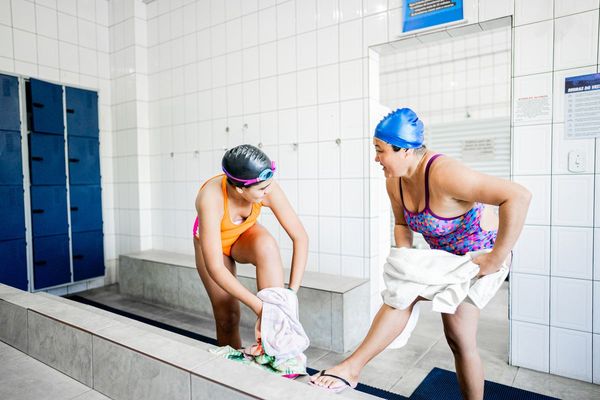
It’s not a good week to be a national record. The Fremantle doctor, Perth’s famous heat and 14mm of vulcanised rubber are exciting clock-watchers at this week’s Australian athletics championships as a new generation of sprint stars take to the swift WA Athletics Stadium.
All-age events are yet to begin but already the meet has delivered one high-profile record – teenager Leah O’Brien’s new under-18 100m mark that is just four hundredths off Torrie Lewis’s senior standard – and emerging stars including Gout Gout and Lachie Kennedy are greedy for more sprinting history after their spectacular recent development.
Kennedy is racing in the 200m against Gout, after the memorable showdown between the pair at the Maurie Plant meet two weeks ago. But they will not meet over 100m, with Kennedy running the open category and Gout only the under-20 event. Regardless, Kennedy is looking at the event as an opportunity to go under the historic 10-second barrier.
“I’m aiming for a sub-10 time for sure. In one of the rounds I’ll do it, and then I want to try and break the Australian record in the 100m,” he said.
His personal best of 10.03s was set at the Perth Track Classic last month just prior to travelling to China for his historic silver medal in the 60m at the world indoor championships.
The national benchmark is 9.93s, with a tailwind of 1.8m/s, set by Patrick Johnson in 2003 in Japan. He is the only Australian to run under 10 seconds legally, but Johnson actually ran faster than his record in Perth the month before he travelled with a tailwind beyond the legal 2m/s limit.
Matt Lynch, state performance adviser at Queensland Athletics, has watched Kennedy and Gout closely in recent months, and believes given the “amazing” conditions in Perth “we could see some special performances”.
Lynch said the ingredients for fast times include the combination of heat – the forecast for Friday is higher than 30C and mid-20s over the weekend – and the world class rubber surface, manufactured by the Mondo company responsible for the world’s best athletic tracks. “That combined with the Fremantle doctor as a tailwind, the dry desert air and cooler evenings, and Perth is primed for fast times,” he said, explaining a cool change helps harden the top of the rubber while the bottom layer remains bouncy.
Johnson’s times in Perth in early 2003, of 9.88s and 9.90s, were set at the now-demolished Perry Lakes track, a site within a kilometre of the new WA Athletics Stadium, built in 2009.
The new venue replicates Perry Lakes’ orientation that opens the track to the dominant local afternoon wind, the Fremantle doctor, that surges in off the Indian Ocean and into the arena at the backs of the athletes running up the home straight.
However Danny Kevan, a sprint coach at the Western Australian Institute of Sport, warned that sometimes the winds in Perth are unpredictable, either swirling around to a headwind or sometimes with a velocity behind runners that is too high for legal times.
The wind is measured by a sensor 50m from the finish line, about a metre from the inside of the track. The reading for each race is an average over 10 seconds from when the gun is fired.
“When we get it right, it’s perfect, look at 1.7 for her [O’Brien’s record-breaking run on Tuesday], you couldn’t have asked for it to be any better, really,” Kevan said. “Or… maybe 1.9.”
The flock of elite sprinters – which also include veterans Rohan Browning and Bree Rizzo (nee Masters) – has pushed excitement in Australian athletics to extreme levels. The Maurie Plant meet in Melbourne last month sold out for the first time in two decades, and the Australian team won a record 14 medals at last year’s under-20 world championships.
The crop of middle distance runners is as promising as the sprinters, and teenagers Cameron Myers and Claudia Hollingsworth are already elite performers who are set to be standard-bearers in the run-up to Brisbane.
Those in field events have already demonstrated to their track peers that Olympic medals are possible. High jumpers Nicola Olyslagers and Eleanor Patterson shared the podium at both the Paris Games as well as at the world indoors last month, while discus thrower Matthew Denny and pole vaulter Nina Kennedy – both who have chosen not to compete in Perth – are among the world’s best in their events.
The spotlight at nationals will also be shared with para-athletes, as James Turner looks to break the 100m T36 world record and local hope and T38 Paralympian Rhiannon Clarke races alongside rising star in the T36 classification, Mali Lovell, in the 100m and 200m.
Kevan, who coaches Clarke, said he understood scheduling challenges faced by organisers but promotion should include para-athletes. “You get Lachie Kennedy there, and you have Jimmy Turner next to him and they’re interviewed together,” he said. “This isn’t para-athletics and able-bodied athletics, this is Athletics Australia and they’re both parallel.”
But he agreed Gout was driving interest in athletics unlike anyone else, and described him making a “once in a lifetime” impact on the sport.
The 17-year-old has been presenting junior athletes at the venue with their medals in between training sessions in preparation for the event. “We need to be good enough now to leverage how good this guy is, and the stuff that’s around him, to bring the rest of the sport with it,” Kevan said.







